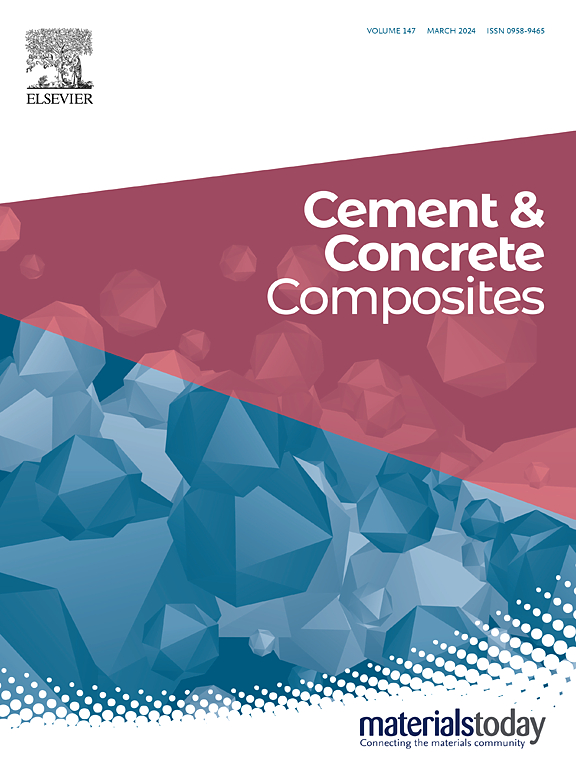将富fe2o3碱渣集成到碱活化材料中:力学和结构性能的评价
IF 13.1
1区 工程技术
Q1 CONSTRUCTION & BUILDING TECHNOLOGY
引用次数: 0
摘要
苏打渣是Na2CO3工业的副产品,它的高碱度是公认的,这可能导致腐蚀和工业过程和实验室基础设施中氧化铁(Fe2O3)的沉积。本研究探讨了将富fe2o3的碱渣(FSR)掺入碱活化材料(AAMs),特别是碱活化粉煤灰(FA)和/或渣粉(SP)对所得材料的新鲜性能和硬化性能的影响。该方法包括通过电导率(EC)和流动性测量来评估材料的可加工性。随着时间的推移,干燥收缩、弯曲和抗压强度的记录被用来评估AAMs的长期硬化性能。为了剖析潜在的机制,采用了一套分析技术。利用x射线衍射(XRD)描述了所存在的矿物相,傅里叶变换红外光谱(FTIR)分析了材料内部的化学键合。扫描电子显微镜与能量色散x射线光谱(SEM-EDS)提供了详细的形态学和元素组成的见解。热重-差示扫描量热法(TG-DSC)进一步表征了组分的热分解行为。结果表明,在FA-SP基质中掺入20% FSR后,经过360天的养护,FA-SP基质的抗折强度和抗压强度显著提高(高于碱活化fa或sp基质),分别达到3.3 MPa和24.3 MPa。此外,观察到干燥收缩适度减少,EC和流动性明显减少。Mg2+(来自SP)和Ca2+(来自SP和FSR)阳离子的释放是Si-O-Al链聚合的关键因素,导致无定形铝硅酸盐结构的形成。Fe2O3和Cr2O3的存在,由于其溶解度低,起到了填料的作用,改善了aam的力学性能。因此,FSR在FA-SP体系中的战略性整合(活性与惰性)可以显著影响铝硅酸盐结构的形成,为可持续AAMs领域工业副产品的增值提供了一条有前途的途径。本文章由计算机程序翻译,如有差异,请以英文原文为准。
Integrating Fe2O3-rich soda residue into alkali-activated materials: Evaluation of mechanical and structural properties
Soda residue, a by-product of the Na2CO3 industry, is recognized for its high alkalinity, which can lead to corrosion and the deposition of iron oxide (Fe2O3) from industrial procedures and lab infrastructure. This study delves into the effects of incorporating Fe2O3-rich soda residue (FSR) into alkali-activated materials (AAMs), specifically alkali-activated fly ash (FA) and/or slag powder (SP), on the fresh and hardened properties of the resulting materials. The methodology encompassed an evaluation of the materials' workability through electrical conductivity (EC) and fluidity measurements. The recordings of drying shrinkage, flexural, and compressive strengths over time were conducted to assess the long-term hardened performance of the AAMs. To dissect the underlying mechanisms, a suite of analytical techniques was employed. X-ray diffraction (XRD) was utilized to delineate the mineral phases present, while Fourier-transform infrared spectroscopy (FTIR) elucidated the chemical bonding within the materials. Scanning electron microscopy with energy-dispersive X-ray spectroscopy (SEM-EDS) provided detailed insights into the morphological and elemental composition. Thermogravimetric-differential scanning calorimetry (TG-DSC) further characterized the thermal decomposition behavior of the constituents. Results indicate that the incorporation of 20 % FSR into the alkali-activated FA-SP matrix resulted in a significant enhancement in flexural and compressive strengths (higher than those of alkali-activated FA-only or SP-only matrix), reaching 3.3 MPa and 24.3 MPa, respectively, after a 360-day curing period. Additionally, a modest reduction in drying shrinkage and a pronounced decrease in EC and fluidity were observed. The release of Mg2+ (from SP) and Ca2+ (from SP and FSR) cations was identified as a key factor in the polymerization of Si–O–Al chains, leading to the formation of amorphous aluminosilicate structures. The physical presence of Fe2O3 and Cr2O3, due to its low solubility, functioned as a filler, improving the mechanical properties of the AAMs. Therefore, the strategic integration (active vs. inert) of FSR into FA-SP systems can significantly influence the formation of aluminosilicate structures, offering a promising avenue for the valorization of industrial by-products in the realm of sustainable AAMs.
求助全文
通过发布文献求助,成功后即可免费获取论文全文。
去求助
来源期刊

Cement & concrete composites
工程技术-材料科学:复合
CiteScore
18.70
自引率
11.40%
发文量
459
审稿时长
65 days
期刊介绍:
Cement & concrete composites focuses on advancements in cement-concrete composite technology and the production, use, and performance of cement-based construction materials. It covers a wide range of materials, including fiber-reinforced composites, polymer composites, ferrocement, and those incorporating special aggregates or waste materials. Major themes include microstructure, material properties, testing, durability, mechanics, modeling, design, fabrication, and practical applications. The journal welcomes papers on structural behavior, field studies, repair and maintenance, serviceability, and sustainability. It aims to enhance understanding, provide a platform for unconventional materials, promote low-cost energy-saving materials, and bridge the gap between materials science, engineering, and construction. Special issues on emerging topics are also published to encourage collaboration between materials scientists, engineers, designers, and fabricators.
 求助内容:
求助内容: 应助结果提醒方式:
应助结果提醒方式:


